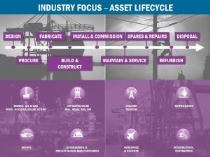One of the more interesting pieces of news that came out this week is that the two biggest economies in the world have for the first time agreed targets to reduce Carbon Emissions. As reported in the NY Times and quoting David B. Sandalow, “For the world’s biggest emitters to be coming together and announcing concrete numbers, serious numbers, sends a signal to the world.”
And of course it does send a real message. Today the story will rumble on as the pressure to agree aggressive targets for reductions focuses on many other countries such as Australia, India, Russia and even Canada. Returning to the main agreement between China and the USA, it will be interesting to see which superpower will actually stick to their words and which will achieve the targets set first.
I had the pleasure recently of speaking at a select gathering of IFS Customers in Shanghai.
Senior representatives from some major energy and utility organizations were at the gathering and topics discussed included corporate performance management and other new utilities functionality improving our linear asset and compatible unit management capabilities.
In addition, we talked through examples of where the deep, world class functionality for project management in IFS Applications has been used for major construction, infrastructure renewal, refurbishment type programs of work. The key to success in these major projects is the ability to integrate all the information generated from all the assets, partners, contractors and suppliers into a single, transparent application. For energy projects, which often have numerous assets scattered over a wide area, huge workforces and seriously complex supply chains, any minor faults can have serious repercussions all the way down the line. Having visibility over all these different aspects of the project is therefore likely to determine whether the project comes in on time and on budget.
And this major capital renewal program returns me to the other story that has been kicking around in the press is the debate over whether the lights go out in the UK this winter. National Grid has warned that its capacity to supply electricity this winter will be at a seven-year low due to generator closures and breakdowns
Spare electricity capacity, which ran at about 5 percent over the winter months last year, would be nearer 4 percent this year, National Grid said. Three years ago the margin was 17 percent.
National Grid’s assessment, made in its 2014/15 Winter Outlook report, is based on similar demand to last winter but a fall in supply, due to generators closing and breaking down, and new plants not coming online quickly enough to replace them.
So clearly we need to further invest and continue the programs launched to provide the electricity of the future. This will invariably be a mix of nuclear, renewables and likely a reducing dependency on traditional fossil fuel stations. Either way new, power stations need to be built and the existing ones maintained in a way that ensures breakdowns and outages are minimized.

IFS delivers the asset lifecycle management (ALM) functionality the energy and utility industry needs.
An integrated asset lifecycle approach is vital for reducing downtime across various assets, and enabling long-term management and maintenance. Any contractor that performs a service, upgrade or lifecycle extension on assets is met with strict quality requirements and demands, with any downtime directly hitting profitability. By integrating project management, logistics, maintenance planning, document management and financial and performance functions, firms can ensure that they schedule and manage maintenance with the utmost efficiency and effectiveness.
Organizations need to define what assets they will keep, enhance or repair, or ultimately replace. This is where an asset management policy, strategy and plan comes in.
What struck me about the event was one of the consistent themes that ran through the conference; the importance of a long term Asset Management Plan (AMP) and how critical it is to be able to look into full asset lifecycle costing. In order to produce this Asset Management Plan, organizations need a business application that has at its heart Asset Lifecycle Management.
IFS has been working in the power industry for over 30 years. Over that time, we have recognized that managing investments in infrastructure, new plant and facilities as well as the normal day-to-day operations and maintenance (O&M) elements is a key differentiator for an enterprise solution. Project management is about more than cost control – it is about asset integrity and risk management. An asset management plan needs to draw data from at least three discrete areas:
- Project: Estimated, planned and committed costs for asset renewal and refurbishment
- Maintenance: Planned and reactive maintenance costs
- Operational costs: Finance FA budgeting and general ledger areas, utility running costs
Project details must be recorded for critical health, safety and environmental (HSE) reasons, and managed across decades of the asset lifecycle. In this industry, an integrated approach across the entire lifecycle is needed to reduce the chance that incorrect decisions are made.
And finally this week, I was fortunate to speak at Water 2014 in London. This is the topic for another day and another post, but it was fascinating to hear how many water treatment companies were solving both their waste recycling issues and the power generation conundrum.
